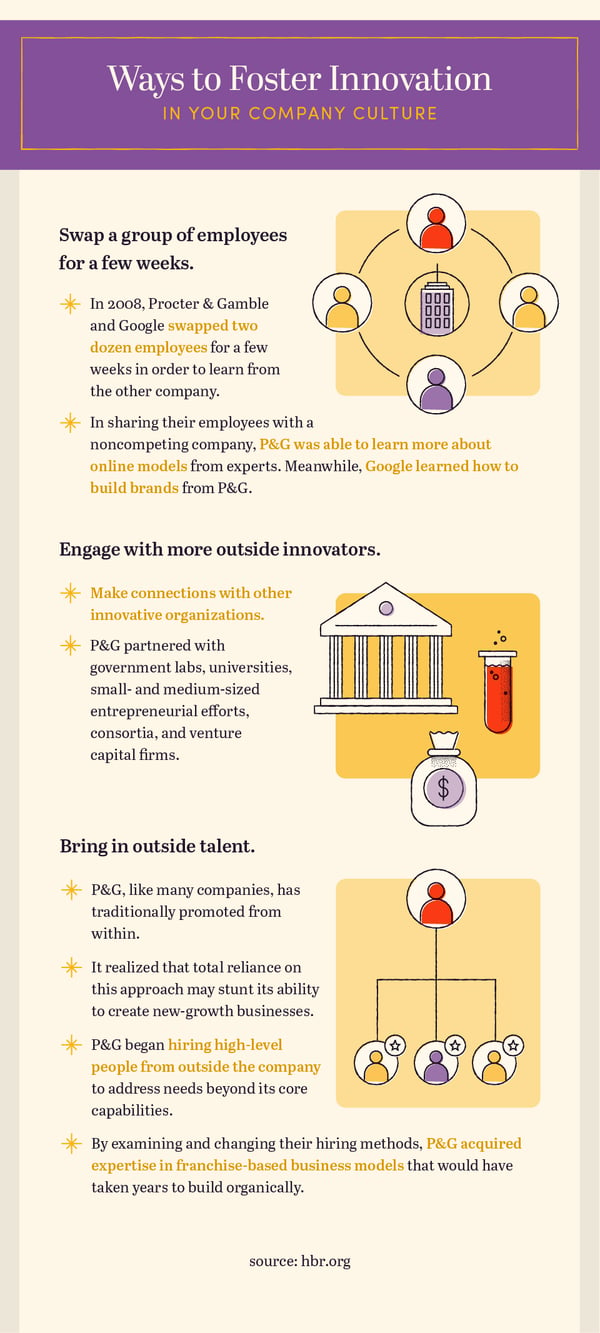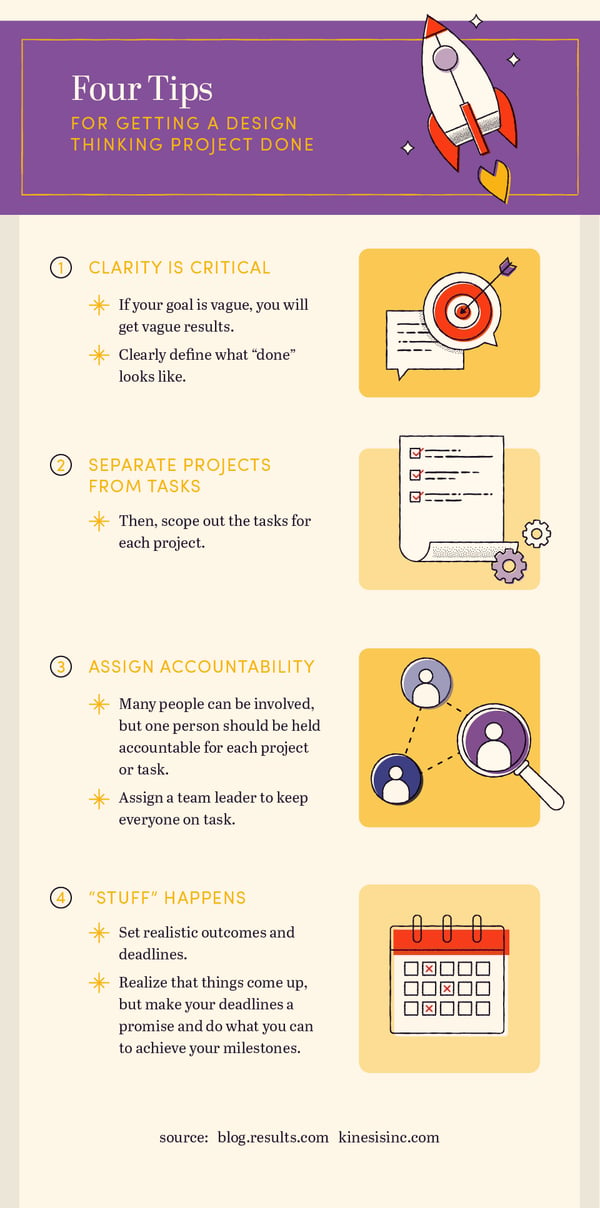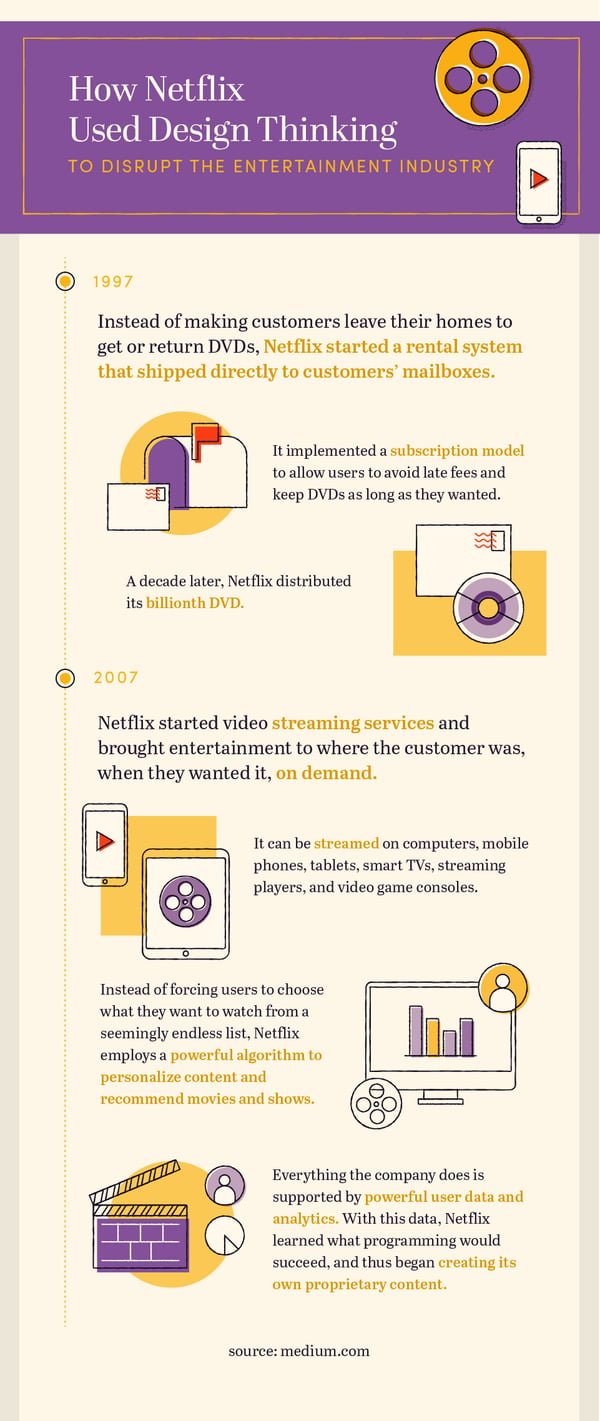Examples of Design Thinking in Action
It has been roughly 20 years since design thinking became a prominent force in the business world. Organizations including Apple, Procter & Gamble (P&G), Coca-Cola, and Intuit, along with many others, use design thinking to innovate around their customers. With this process, they can build better products and drive business success. These companies have proven that putting design thinking at the center of their business strategy, then implementing the approach company-wide is one of the best ways to foster innovation.
Often, design-driven organizations outperform and disrupt their industries. They understand the process and push to use it in all aspects of their business. Because of this, these organizations can more intuitively use design thinking and replicate their successes, which helps them drive innovation. After all, design thinking is a great method to use to stay focused on the user when solving problems that arise from complex systems and new technologies.
When embraced, design thinking can be the facilitator that bridges worlds and helps create a solution the user wants, with the right technology, and powerful market fit.
The following case studies are all examples of how design thinking can be leveraged as part of a business strategy to inspire creative problem solving. It can be used across various industries, as well as within both new and well-established markets.

Procter & Gamble’s Swiffer
Design can be a game changer in industries that are the most “traditional” or commoditized, such as home cleaning. P&G saw an opportunity to make a change even when they were a market leader in the category.
P&G worked with a design firm to assist in incorporating the design thinking process. In order to learn more about their users and the process of cleaning floors, the team visited their users at home to observe as they completed this chore. “They noticed that people usually swept before they mopped, that they spent an inordinate amount of time rinsing, and that it was overall a dirty job.” The fact that mopping is an unpleasant chore was unsurprising. However, the number of steps users took in order to mop and the clumsiness of the process meant the team had a challenge design thinking could help solve: “Find a better way to clean floors in the home.”
In order to improve this process, the team needed to create a product that would cut the amount of effort and time spent in half. The product would need to be able to both sweep up dust and rinse away dirt at the same time.
This resulted in the creation of the Swiffer Mop, a product based around the design principle of a “fast clean.” It turned a time-intensive and demanding chore into a fast and simple task that made it easy for users to quickly clean and dispose of dirt without getting their hands dirty.
Swiffer is one of P&G’s most successful and popular product launches, generating over $100 million in sales after selling more than 11 million starter kits within the first year. By taking the time to understand the pains their users had to go through to clean floors, Procter & Gamble was able to develop a product that both helped customers in a much-needed way and revitalized the cleaning industry.
 PepsiCo and Spire
PepsiCo and Spire
PepsiCo recently decided to make design the center of their business strategy, which resulted in their reimagined version of the soda fountain. This product, Spire, is the company’s first innovation using a design thinking approach.
The Spire soda fountain lets users customize their beverage by choosing and adding flavours. A similar product, the Coca-Cola Freestyle, was the first attempt to rethink the soda fountain as a sleek and fun experience. Spire learned from the Freestyle and improved on the machine itself, making it smaller and easier to maintain for businesses that bought it. It also allows users to create more than a thousand drink combinations. Furthermore, in an effort to engage with their users, PepsiCo created a competition around the beverage combinations users create.
In the future, PepsiCo hopes to release a series of products around Spire and incorporate the design thinking process into more of their offerings.
Intuit
Intuit is great example of a company that introduced a product in an already saturated market; in this case, it was financial software. Their biggest differentiator was that they put the user first to design a product that was intuitive and easy to use.
Intuit learned that users struggled with using technology and spreadsheets. That meant users faced a steep learning curve and challenges with software adoption.
That’s when Intuit drew inspiration from what their users were already familiar with to display their accounting data — a check register and an individual check, rather than spreadsheets. By changing the interface into something familiar, Intuit created an advantage over their competitors. The learning curve for their software was easier for customers, who could confidently use Intuit’s Quicken software without much support.
As the success of their software grew, Intuit co-founder Scott Cook admitted that design did not always remain at the center of their business strategy. For a time, Intuit only focused on ease of use. This caused it to lose sight of what gave them their initial advantage: an understanding of how their users felt while doing their finances.
Cook decided to make products that users would find pleasurable to use, not just easy. This resulted in a new strategy called “design for delight” which saw QuickBooks Online and TurboTax and the acquisition of Mint a free, web-based personal financial management service.
Intuit proved that financial software could be revamped with customers in mind. When designed well, it can improve the tedious tasks most people dread when it comes to managing their finances. By embracing design thinking and what they know their customers need, Intuit became a household name and market leader.

Netflix
In the last few decades, Netflix has blazed its own path within the entertainment industry, using design thinking to stay focused on creating a personalized, groundbreaking experience for their users.
Netflix’s business is centered around personalized entertainment, and because of that, it uses a powerful recommendation engine to serve content to users in a delightful way. Over the years, this has been the core of their service offering, and it’s something they constantly improve and leverage to grow their user base and offering.
First, they started as a web-based catalog to rent DVDs through the mail. With it, Netflix made waves and ultimately disrupted the movie rental industry, causing movie rental businesses to close their doors. This disruption didn’t stop Netflix from continuing to find new ways to bring better entertainment offerings to their users. Leveraging technology and their recommendation algorithm, the company is now disrupting the cable TV industry with their groundbreaking streaming service.
Netflix made entertainment available at any time and any place — users have all the power at their fingertips. Its innovative service continues to shape a new kind of entertainment industry, one that’s now powered by user data collected over the years. For example, Netflix is creating more content for its users based on their preferences and viewing habits. It produces many hit shows, many of which are only available through their service. As Netflix leads the way, other companies, such as Amazon and Hulu, are following in its footsteps.
Airbnb
The idea for Airbnb came to cofounders Joe Gebbia and Brian Chesky while they were trying to figure out ways to make some quick cash to pay their rent in San Francisco. Once they put up their first iteration of the service, inquiries from around the world came in from people asking if Airbnb could feature their homes for travelers who needed a place to stay.
Gebbia and Chesky saw an opportunity to create a hospitality revolution, but they knew they had an important problem to solve: They needed to research their users.
They learned their average user was educated, younger, financially stable, and looking to stay in a comfortable and personal home environment instead of a hotel with many guests. The social aspect had great appeal to these affluent millennials who were looking for a unique experience as a way to feel like they were a part of the cities they were staying in. Once they began catering to their users and what they wanted, the site’s popularity grew. Airbnb became a platform for users to become their own travel agents, renting unique spaces from strangers all over the world.
Design Thinking Disrupts Industries
Companies are using design thinking to launch new products, improve upon products already on the market, and create entirely new companies geared toward exactly what customers want. With a focus on users’ needs and a desire to be customer-centric, these companies have both turned profits and earned reputations for listening to what their customers need — and serving them.